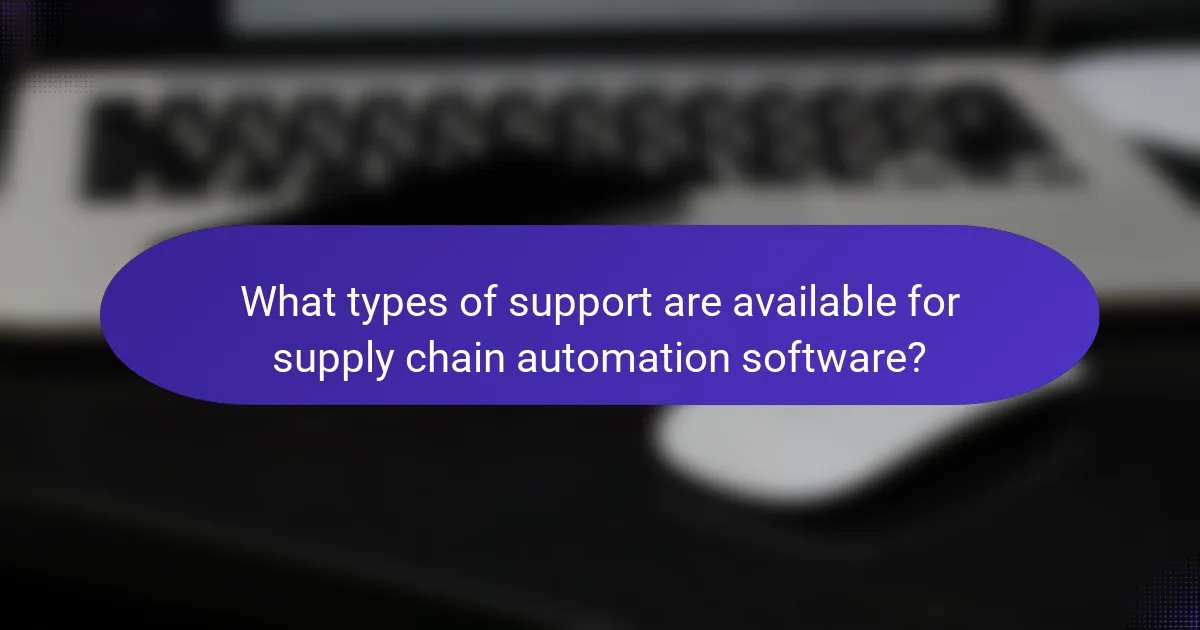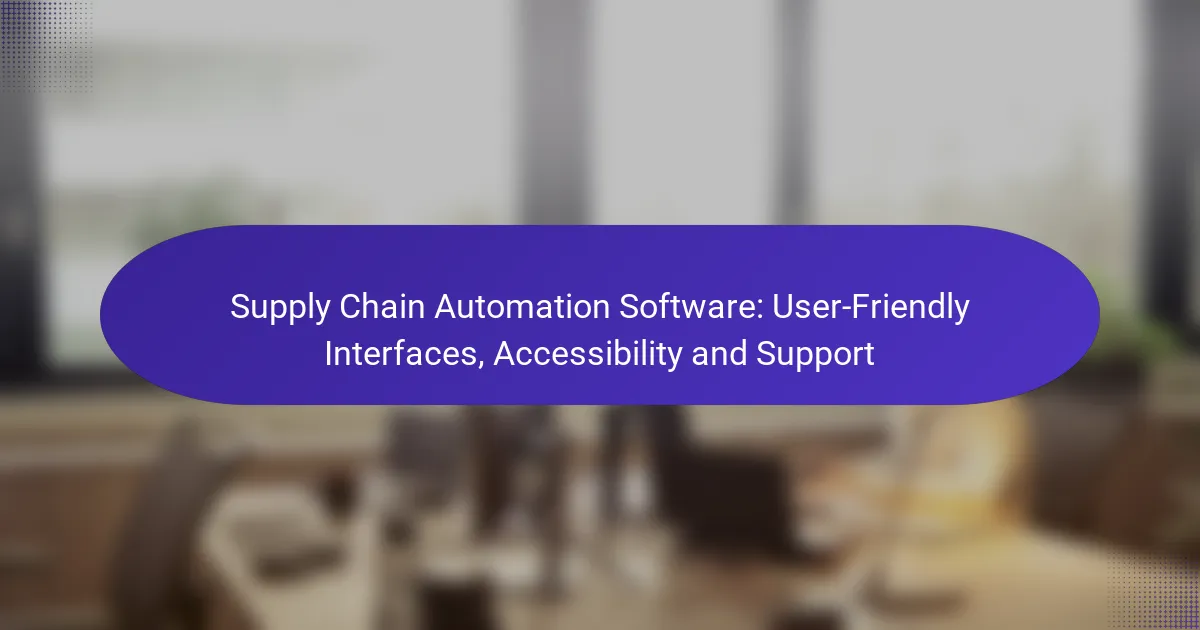Supply chain automation software plays a crucial role in optimizing processes and enhancing decision-making across businesses. With user-friendly interfaces and accessibility features, these tools ensure that complex operations are manageable for all users, ultimately driving efficiency and productivity. Leading solutions like Oracle SCM Cloud and SAP Integrated Business Planning offer tailored capabilities to meet diverse business requirements.

What are the best supply chain automation software options?
The best supply chain automation software options streamline processes, enhance visibility, and improve decision-making. Key players in this space include Oracle SCM Cloud, SAP Integrated Business Planning, Kinaxis RapidResponse, Blue Yonder Luminate, and Infor CloudSuite Supply Management, each offering unique features and capabilities tailored to various business needs.
Oracle SCM Cloud
Oracle SCM Cloud provides a comprehensive suite of applications designed to optimize supply chain processes. Its user-friendly interface allows for easy navigation, enabling teams to manage logistics, procurement, and product lifecycle seamlessly.
Consider its robust analytics capabilities, which help businesses forecast demand and manage inventory effectively. Companies often find that implementing Oracle SCM Cloud can lead to significant reductions in operational costs and improved service levels.
SAP Integrated Business Planning
SAP Integrated Business Planning (IBP) focuses on aligning supply chain planning with business goals. Its intuitive dashboard offers real-time insights, allowing users to make informed decisions quickly.
IBP’s strength lies in its ability to integrate with existing SAP systems, providing a cohesive experience. Businesses should evaluate their current infrastructure to ensure compatibility and maximize the benefits of this powerful tool.
Kinaxis RapidResponse
Kinaxis RapidResponse is known for its agility and responsiveness in supply chain management. It offers a cloud-based platform that enables companies to simulate various scenarios and assess their impact on the supply chain.
This software is particularly beneficial for industries with fluctuating demand, as it allows for rapid adjustments to plans. Companies should leverage its collaborative features to enhance communication across teams and improve overall efficiency.
Blue Yonder Luminate
Blue Yonder Luminate utilizes artificial intelligence to enhance supply chain visibility and decision-making. Its user-friendly interface makes it accessible for teams at all levels, promoting widespread adoption within organizations.
With features like demand forecasting and inventory optimization, Blue Yonder helps businesses reduce stockouts and excess inventory. Companies should consider their specific needs when selecting modules to implement for maximum impact.
Infor CloudSuite Supply Management
Infor CloudSuite Supply Management offers a tailored approach to supply chain automation, focusing on industry-specific solutions. Its intuitive design supports easy access to critical data, enabling users to manage suppliers and logistics efficiently.
Organizations should assess their unique requirements to take full advantage of Infor’s capabilities. Additionally, its integration with other Infor products can enhance overall supply chain performance, making it a strong contender for businesses looking for comprehensive solutions.

How do user-friendly interfaces enhance supply chain automation?
User-friendly interfaces significantly improve supply chain automation by making complex processes more accessible and manageable. They allow users to navigate systems easily, reducing training time and increasing overall efficiency.
Intuitive dashboards for real-time insights
Intuitive dashboards provide users with immediate access to key performance indicators and metrics, enabling quick decision-making. These visual representations often include graphs, charts, and alerts that highlight critical data points, making it easier to monitor supply chain health.
For example, a dashboard might display inventory levels, order statuses, and shipment tracking in one view, allowing managers to identify issues and opportunities swiftly. This immediate visibility can lead to faster response times and improved operational efficiency.
Customizable workflows for efficiency
Customizable workflows allow businesses to tailor processes to their specific needs, enhancing efficiency and productivity. Users can adjust workflows to reflect their unique supply chain dynamics, ensuring that tasks align with organizational goals.
For instance, a company might create a workflow that automates order processing, from receipt to fulfillment, reducing manual errors and saving time. This flexibility helps organizations adapt to changing market conditions and customer demands, ultimately leading to better service delivery.

What accessibility features should supply chain software include?
Supply chain software should include accessibility features that enhance usability for all users, including those with disabilities. Key features often encompass screen reader compatibility, keyboard navigation, and customizable interface options to accommodate various needs.
Mobile access for on-the-go management
Mobile access is crucial for supply chain management, allowing users to monitor operations and make decisions from anywhere. A user-friendly mobile interface should provide essential functionalities like real-time tracking, inventory updates, and notifications.
When selecting software, ensure it offers a responsive design that adapts to different screen sizes and operating systems. Consider apps that support offline access, enabling users to manage tasks without a constant internet connection.
Multi-language support for global teams
Multi-language support is essential for supply chain software used by international teams. This feature ensures that users can operate in their preferred language, enhancing communication and reducing errors in critical processes.
Look for software that offers a wide range of languages and allows easy switching between them. Additionally, consider platforms that provide localized content, including currency formats and regional compliance information, to better serve diverse teams.

What types of support are available for supply chain automation software?
Supply chain automation software typically offers various support options to ensure users can effectively utilize the system. These include 24/7 customer support services and comprehensive training programs designed to enhance user experience and proficiency.
24/7 customer support services
Many supply chain automation software providers offer round-the-clock customer support to address user inquiries and technical issues. This support can be accessed via multiple channels, including phone, email, and live chat, ensuring assistance is available whenever needed.
When evaluating customer support, consider response times and the availability of knowledgeable representatives. Aim for providers that guarantee quick resolutions, ideally within a few hours, to minimize disruptions in your supply chain operations.
Comprehensive training programs
Comprehensive training programs are essential for maximizing the benefits of supply chain automation software. These programs often include online tutorials, webinars, and in-person workshops that cater to different learning styles and user needs.
Look for training options that cover both basic functionalities and advanced features. A good program should allow users to become proficient within a few sessions, typically ranging from a few hours to a couple of days, depending on the software complexity.

What are the key criteria for selecting supply chain automation software?
When selecting supply chain automation software, prioritize user-friendly interfaces, accessibility, and robust support. These criteria ensure that the software can be effectively utilized by all team members, facilitating smooth operations and minimizing disruptions.
Scalability to meet business growth
Scalability is crucial for supply chain automation software, as it allows the system to adapt to increasing volumes and complexities of operations. Look for solutions that can handle growth without significant additional costs or system overhauls.
Consider software that offers tiered pricing or modular features, enabling you to add capabilities as your business expands. This flexibility can save costs in the long run and ensure that your software remains aligned with your operational needs.
Integration capabilities with existing systems
Effective supply chain automation software must seamlessly integrate with your current systems, such as ERP, CRM, and inventory management tools. This integration minimizes data silos and enhances overall efficiency.
Evaluate the software’s compatibility with your existing technology stack. Look for solutions that support common standards and protocols, which can simplify the integration process. A well-integrated system can lead to improved data accuracy and faster decision-making.

How can businesses ensure successful implementation of supply chain automation?
Businesses can ensure successful implementation of supply chain automation by thoroughly evaluating their existing processes and setting clear, measurable objectives. This approach helps identify areas for improvement and aligns automation efforts with overall business goals.
Step 1: Assess current processes
Start by conducting a comprehensive review of your current supply chain processes. Identify bottlenecks, inefficiencies, and areas where manual intervention is frequent. This assessment should involve key stakeholders across departments to gather diverse insights.
Utilize tools like process mapping to visualize workflows and pinpoint specific tasks that could benefit from automation. Consider metrics such as time spent on manual tasks and error rates to prioritize which processes to automate first.
Step 2: Define clear objectives
Once you have assessed your current processes, define clear objectives for your automation efforts. Objectives should be specific, measurable, achievable, relevant, and time-bound (SMART). For example, aim to reduce order processing time by 30% within six months.
Communicate these objectives across the organization to ensure alignment and buy-in from all team members. Regularly review progress against these goals and adjust strategies as needed to stay on track and maximize the benefits of automation.


